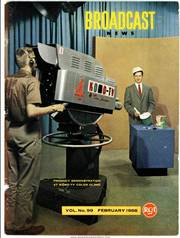RCA - "BROADCAST NEWS" - Vol. No. 99 February, 1958
published by RADIO CORPORATION OF AMERICA - BROADCAST & TELEVISION EQUIPMENT DIVISION, CAMDEN, NEW JERSEY. - Copyright 1958
.
Das RCA Magazin vom Februar 1958 hat nur drei interessante Artikel ....
CONTENTS
- COLOR VIDEO TAPE RECORDER - COLOR PROCESSING....... 6
- KGHL-TV GETS FIRST TRAVELING wave ANTENNA 8
- A NEW AURAL AND VISUAL TV EXCITER...... 10
- PLANNING A RADIO STATION-PART III...... 14
- FISHER RADIO STATIONS......... 26
- HOW KOMO-TV USES COLOR CLINICS...... 36
- WUNC-TV-NORTH CAROLINA ETV STATION..... 52
das hier war interessant : - TRANSISTORIZED TURNTABLE PREAMPLIFIER .. 78
Der Artikel auf Seite 6 über die Farb-wiedergabe des RCA Farbrecorders ist ein typisches Beispiel, wie man soetwas Technisches eigentlich nicht erklären sollte. Die wenigsten Leser hatten das wirklich kapiert.
Der Artikel Seite 36 über den Sender KOMO TV hingegen gibt uns einen tiefen Einblick in die Geschichte des amerikanischen Fernsehens und die Entwicklung der Farbe.
.
Und der Artikel über den ersten transistorisierten Phono Vorverstärker auf Seite 78 gehört ins Hifimuseum.
.
COLOR PROCESSING IN RCA VIDEO TAPE RECORDER
NEW SIGNAL-PROCESSING TECHNIQUES ARE KEY TO COLOR PERFORMANCE
by A. H. Lind, Manager, Audio and Mechanical Devices Engineering
.
Intro
The equipment requirements for reproducing color TV signals from magnetic tape are more stringent (strnger, härer) than they are for monochrome TV signals.
First, the response at the high end of the video channel must permit the chrominance information to pass. Second, a tight phase relationship between the average subcarrier burst frequency and phase and the hue modulated subcarrier must be present in the transmitted color signal.
.
Der "RCA TRT-1AC" Color Video Tape Recorder
In the "RCA TRT-1AC" Color Video Tape Recorder the speed of the head wheel when reproducing a recorded signal is maintained sufficiently constant to introduce very little phase shift in the color subcarrier during any given TV line.
However, the phase relation in a succession of color subcarrier bursts is subject to spurious shifts due to slow, minute variations in head wheel speed and small errors in the quadrature relation of the playback heads.
If, as is usually the case in color TV receivers, the local subcarrier oscillator is locked to the incoming subcarrier bursts in a manner that averages many bursts, the demodulated color signal would display hue errors as a function of the timing inaccuracies. At the present state of the speed control art, the resulting picture would be unusable.
.
Block diagram, Fig. 2
The system shown in the simplified block diagram, Fig. 2, is used quite successfully to correct for the small timing errors and thus eliminate the related color distortion. The basic technique is to cancel out color phase drift in the chrominance signal by translating this signal to a higher frequency spectrum, and then heterodyning this translated signal with a signal which also contains the phase drift and is of such a frequency that the difference signal frequencies fall back into the original frequency band.
If this signal is derived from a signal recorded on the tape, it will contain the same phase-drift effects as those in the translated chrominance signal, but the difference signal obtained by heterodyning will be free of phase drift because errors have been cancelled by subtraction.
.
Separation from chrominance and luminance
The video input signal (see Fig. 2), which contains color phase drift is divided into two frequency bands by filters. The higher frequency band contains the chrominance information.
This 3 to 4 mc band (MHz) of signals is translated to a 22.8 to 23.8 mc band by mixing it with a 19.8 mc signal. The 19.8 mc signal is obtained by multiplication of a local crystal subcarrier oscillator. The signal in the 22.8 to 23.8 mc band still contains the color phase drift.
The reference signal is the color sub-carrier burst which conveniently is an inherent part of the color video signal. However, the subcarrier burst must be used to precisely control a local oscillator that can provide a continuous subcarrier.
By using a burst-controlled oscillator which is synchronized by each burst and sustains the oscillation for the remainder of the TV line, the output subcarrier is effectively step modulated a line at a time in accordance with the color phase drift present.
.
Signal is translated to 19.8 megacycle area
This signal is translated to 19.8 mc by mixing it with a 16.2 mc signal which is also obtained by multiplication from the local color subcarrier signal (see Fig. 2).
Next, the 22.8 to 23.8 mc signal is mixed with the 19.8 mc signal. Both signals contain color phase drift. A difference sideband signal of 3 to 4 mc in which the phase drift has been cancelled is produced.
The color stabilized 3 to 4 mc signal is then added to the 0 to 3 mc luminance signal to reconstitute the color video signal. A burst-restorer unit reinserts a new sub-carrier burst to insure a clean, well-shaped burst on the output color signal.
The output signal resulting from these color-processing techniques is a composite color signal ready for transmission.
FIG. 1. Prototype of the Color Video Tape Recorder and the author.
FIG. 2. Simplified block diagram of color processing circuits.

